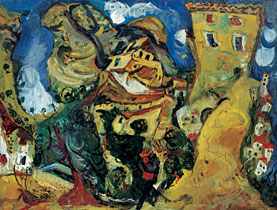The visionary painting of an agonised soul

Chaim Soutine, a Belarussian Jewish painter whose bold works reveal deep emotion and turmoil, is the subject of a special exhibition at Basel's Fine Arts Museum.
It aims to show how the rediscovered Soutine, a contemporary and friend of Marc Chagall and Amedeo Modigliani, developed his unique technique during a time of great change in art.
Soutine (1893-1943), who lived and worked in Paris for most of his career, is generally considered to have a style closely related to early 20th century Expressionism.
He kept his distance from the new art movements, even those originating in the French capital, such as Cubism, Futurism and Surrealism.
Instead Soutine developed a highly individualistic style characterised by the use of thick impasto – paint applied thickly – agitated brushwork and strong emotional content.
But as the exhibition of around 60 works aims to show, he was not totally immune to developments around him.
“We wanted to show with this retrospective, which allows the visitor to discover landscapes, portraits and still lifes from all phases of Soutine’s life, that he was not such a solitary artist as normally thought,” said curator Nina Zimmer.
“There were points of contact [in his work] with many of his artist colleagues, even those in Paris. Soutine was not so different from Chagall, Modigliani or Maurice Utrillo.
“The exhibition also highlights parallels with Georges Braque and Pablo Picasso,” she added.
Buzzing Paris
The artist was born to a poor family in what is now Belarus and came to Paris in 1913 at the age of 20. The city was buzzing with young artists in search of new methods to shake up traditional art.
Soutine, too, became immersed in this atmosphere, continuing this quest throughout his life.
“The plane geometry problem, which came around the time of Cézanne and inspired Picasso and Braque to found Cubism, influenced Soutine but he found an artistic solution that was very different to the Cubists,” said Zimmer.
This can be seen in two pictures – a still life of 1916 and one depicting the views from the village of Céret in France from the 1920s – that are placed next to similar paintings by Picasso and Braque.
But unlike these Cubist works, the collapsing perspective seen in Soutine’s works is accompanied by powerful brushstrokes and distorted figuration, testament to his strong psychological identification with his subject matter.
Turbulence and balance
The dark still lifes of animal carcases, the tragic figures of his portraits and the shocking, but visionary landscapes that fill the seven rooms of the exhibition show the artist’s dramatic view of the world.
This intensity is underlined by the extreme way in which Soutine uses colour – for example in the violent contrasts of light present in many of his portraits.
In addition to the famous beef carcasses paintings from 1925, many lesser-known works are on display, which come from the period when Soutine is considered to have achieved artistic maturity.
These images, painted between 1922 and 1925 and showing the countryside around Cagnes in the south of France, seem to show through their more harmonious use of shape and colour that for a time Soutine found a balance between his expressive spontaneity and his emotions.
Long-lasting influence
Soutine’s “revolutionary potential” exerted an influence well into the 20th century and he is credited with inspiring abstract American artist Willem de Kooning as well as British artists Francis Bacon and Damien Hirst.
“Soutine is a very modern artist whose painting has a freedom and intensity which still continues to influence artists today,” said Zimmer. “But he was also a traditionalist. He always used the portrait, landscape and still life and never wavered from this.”
Although he was interested in finding new ways of expression, the painter did not depict scenes of modern life and industrialisation in his works, a trend already started by the Impressionists.
His traditionalism is what gave him the energy to reinvent painting techniques and express his emotions, says Zimmer.
“Soutine, who came from Smilovichi, this small village near Minsk in [what was then] Belorussia, wanted to become a great artist,” she said.
“This seems a crazy idea at the time, but in the end I really believe he managed it.”
swissinfo, based on an Italian article by Paola Beltrame in Basel
Soutine was born around 1893 in Smilovichi, a village in what is now Belarus, to a Jewish family of Lithuanian origin. He studied art in Minsk and Vilnius.
With two friends he left for Paris in 1913 where he came into contact with Marc Chagall, with whom he shared not only artistic ideas but also his origin, as well as Amedeo Modigliani and Maurice Utrillo. The four became friends.
Soutine was considered to be a difficult man, introverted and unsociable. He did not belong to any art movement, instead creating an independent style. Collectors started buying his works in the 1920s, guaranteeing him an income.
He fled Paris during the Second World War and died in 1943 after returning to the French capital for a stomach operation.
Soutine and Modernism is being shown at Basel Fine Arts Museum until July 7, 2008.
It shows around 60 of Soutine’s works alongside those of contemporaries such as Chagall and Picasso.
One point of departure for the exhibition is the Im Obersteg Collection which is on permanent loan to the Fine Arts Museum.
Soutine’s works are also to be found in private collections in Switzerland, especially in Geneva.

In compliance with the JTI standards
More: SWI swissinfo.ch certified by the Journalism Trust Initiative
You can find an overview of ongoing debates with our journalists here. Please join us!
If you want to start a conversation about a topic raised in this article or want to report factual errors, email us at english@swissinfo.ch.